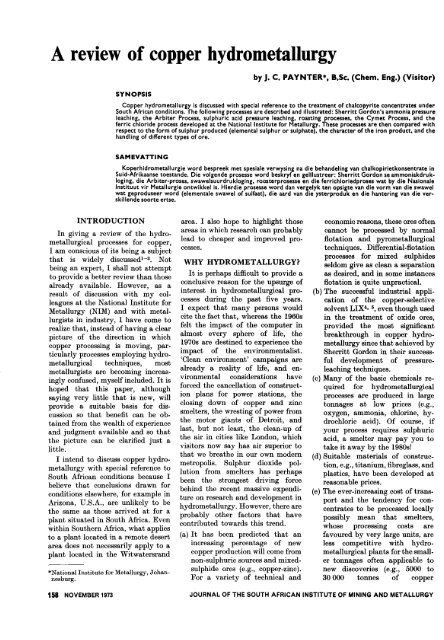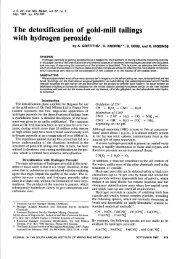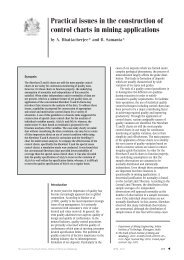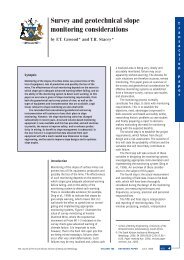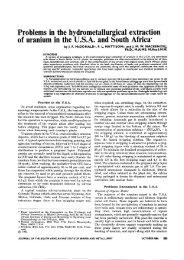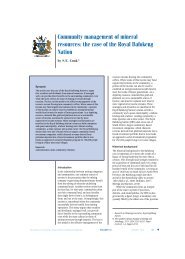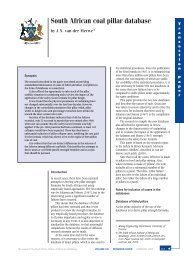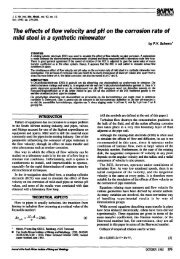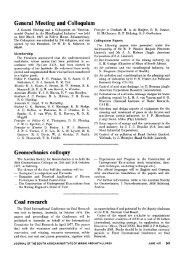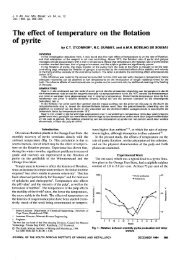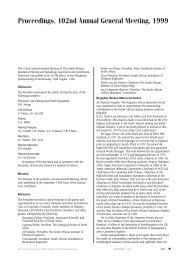A review of copper hydrometallurgy - saimm
A review of copper hydrometallurgy - saimm
A review of copper hydrometallurgy - saimm
Create successful ePaper yourself
Turn your PDF publications into a flip-book with our unique Google optimized e-Paper software.
A <strong>review</strong><br />
<strong>of</strong> <strong>copper</strong> <strong>hydrometallurgy</strong><br />
by j. C. PAYNTER*, B.Sc. (Ch em. Eng.) (Visitor)<br />
SYNOPSIS<br />
Copper. hydrom~t~lIurgy is discus~ed with special reference to the treatment <strong>of</strong> chalcopyrite concentrates under<br />
Sout~ African con~ltlons. The following processes are described and illustrated: Sherritt Gordon's ammonia pressure<br />
leac~lng, t~e Arbiter Process, sulphuric acid pressure leaching, roasting processes, the Cymet Process, and the<br />
ferric chloride process developed at the National Institute for Metallursy. These processes are then compared with<br />
respect to the form <strong>of</strong> sulphur produced (elemental sulphur or sulphate), the character <strong>of</strong> the iron product and the<br />
handling <strong>of</strong> different types <strong>of</strong> ore.<br />
.<br />
SAMEVATTING<br />
~oper.hidrometallurgie wo~d bespreek met spesiale verwysing na die behandeling van chalkopirietkonsentrate in<br />
Sul?-Afrl.kaanse. toestande.<br />
logl~g, die. Arblter-pr~ses,<br />
Die volgende prosesse word beskryf en geillustreer: Sherritt Gordon se ammoniakdruk-<br />
sw~wels~urd~ukl?ging, roosterprosesse en die ferrichloriedproses wat by die Nasionale<br />
Instltuut vir Metallurgle ontwlkkells. Hlerdle prosesse word dan vergelyk ten opsigte van die vorm van die swawel<br />
wat geproduseer word (elementale swawel <strong>of</strong> sulfaat), die aard van die ysterproduk en die hantering van die verskillende<br />
soorte ertse.<br />
INTRODUCTION<br />
In giving a <strong>review</strong> <strong>of</strong> the hydrometallurgical<br />
processes for <strong>copper</strong>,<br />
I am conscious <strong>of</strong> its being a subject<br />
that is widely discussedl-3. Not<br />
being an expert, I shall not attempt<br />
to provide a better <strong>review</strong> than those<br />
already available. However, as a<br />
result <strong>of</strong> discussion with my colleagues<br />
at the National Institute for<br />
Metallurgy (NIM) and with metallurgists<br />
in industry, I have come to<br />
realize that, instead <strong>of</strong> having a clear<br />
picture <strong>of</strong> the direction in which<br />
<strong>copper</strong> processing is moving, particularly<br />
processes employing hydrometallurgical<br />
techniques, most<br />
metallurgists are becoming increasingly<br />
confused, myself included. It is<br />
hoped that this paper, although<br />
saying very little that is new, will<br />
provide a suitable basis for discussion<br />
so that benefit can be obtained<br />
from the wealth <strong>of</strong> experience<br />
and judgment available and so that<br />
the picture can be clarified just a<br />
little.<br />
I intend to discuss <strong>copper</strong> <strong>hydrometallurgy</strong><br />
with special reference to<br />
South African conditions because I<br />
believe that conclusions drawn for<br />
conditions elsewhere, for example in<br />
Arizona, D.S.A., are unlikely to be<br />
the same as those arrived at for a<br />
plant situated in South Africa. Even<br />
within Southern Africa, what applies<br />
to a plant located in a remote desert<br />
area does not necessarily apply to a<br />
plant located in the Witwatersrand<br />
"National Institute for Metallurgy, Johannesburg.<br />
area. I also hope to highlight those<br />
areas in which research can probably<br />
lead to cheaper and improved processes.<br />
WHY<br />
HYDROMETALLURGY?<br />
It is perhaps difficult to provide a<br />
conclusive reason for the upsurge <strong>of</strong><br />
interest in hydrometallurgical processes<br />
during the past five years.<br />
I expect that many persons would<br />
cite the fact that, whereas the 1960s<br />
felt the impact <strong>of</strong> the computer in<br />
almost every sphere <strong>of</strong> life, the<br />
1970s are destined to experience the<br />
impact <strong>of</strong> the environmentalist.<br />
'Clean environment' campaigns are<br />
already a reality <strong>of</strong> life, and environmental<br />
considerations have<br />
forced the cancellation <strong>of</strong> construction<br />
plans for power stations, the<br />
closing down <strong>of</strong> <strong>copper</strong> and zinc<br />
smelters, the wresting <strong>of</strong> power from<br />
the motor giants <strong>of</strong> Detroit, and<br />
last, but not least, the clean-up <strong>of</strong><br />
the air in cities like London, which<br />
visitors now say has air superior to<br />
that we breathe in our own modern<br />
metropolis. Sulphur dioxide pollution<br />
from smelters has perhaps<br />
been the strongest driving force<br />
behind the recent massive expenditure<br />
on research and development in<br />
<strong>hydrometallurgy</strong>. However, there are<br />
probably other factors that have<br />
contributed towards this trend.<br />
(a) It has been predicted that an<br />
increasing percentage <strong>of</strong> new<br />
<strong>copper</strong> production will come from<br />
non-sulphuric sources and mixedsulphide<br />
ores (e.g., <strong>copper</strong>-zinc).<br />
For a variety <strong>of</strong> technical and<br />
economic reasons, these ores <strong>of</strong>ten<br />
cannot be processed by normal<br />
flotation and pyrometallurgical<br />
techniques. Differential-flotation<br />
processes for mixed sulphides<br />
seldom give as clean a separation<br />
as desired, and in some instances<br />
flotation is quite unpractical.<br />
(b) The successful industrial application<br />
<strong>of</strong> the <strong>copper</strong>-selective<br />
solvent LIX4. 5, even though used<br />
in the treatment <strong>of</strong> oxide ores,<br />
provided the most significant<br />
breakthrough in <strong>copper</strong> <strong>hydrometallurgy</strong><br />
since that achieved by<br />
Sherritt Gordon in their successful<br />
development <strong>of</strong> pressureleaching<br />
techniques.<br />
(c) Many <strong>of</strong> the basic chemicals required<br />
for hydrometallurgical<br />
processes are produced in large<br />
tonnages at low prices (e.g.,<br />
oxygen, ammonia, chlorine, hydrochloric<br />
acid). Of course, if<br />
your process requires sulphuric<br />
acid, a smelter may pay you to<br />
take it away by the 1980s!<br />
(d) Suitable materials <strong>of</strong> construction,<br />
e.g., titanium, fibreglass, and<br />
plastics, have been developed at<br />
reasonable prices.<br />
(e) The ever-increasing cost <strong>of</strong> transport<br />
and the tendency for concentrates<br />
to be processed locally<br />
possibly mean that smelters,<br />
whose processing costs are<br />
favoured by very large units, are<br />
less competitive with hydrometallurgical<br />
plants for the smaller<br />
tonnages <strong>of</strong>ten applicable to<br />
new discoveries (e.g., 5000 to<br />
30000 tonnes <strong>of</strong> <strong>copper</strong><br />
158 NOVEMBER 1973<br />
JOURNAL OF THE SOUTH AFRICAN<br />
INSTITUTE OF MINING AND METALLURGY
annually). Many local companies<br />
have recently found that the<br />
cost <strong>of</strong> transporting concentrates,<br />
custom smelting, and refining has<br />
risen so much that the need to<br />
consider their own processing<br />
facilities is becoming increasingly<br />
pressIng.<br />
(f) As the price <strong>of</strong> <strong>copper</strong> has ]isen,<br />
the importance <strong>of</strong> working capital<br />
tied up in <strong>copper</strong> inventory has<br />
increased, and it is believed that<br />
virtually all hydrometallurgical<br />
processes will have a lower inventory<br />
than that <strong>of</strong> conventional<br />
pyrometallurgical processes.<br />
Despite the enormous effort being<br />
directed to research in hydrometallurgical<br />
processes, an equal, if not<br />
larger, effort is being devoted to the<br />
following:<br />
(i) improvements in existing pyrometallurgical<br />
processes, with<br />
special emphasis on the control<br />
<strong>of</strong> sulphur dioxide pollution, and<br />
(ii) developments in new pyrometallurgical<br />
processes in which the<br />
smelting and converting steps<br />
are integrated into one continuous<br />
operation (or sequence<br />
<strong>of</strong> operations), and which produce<br />
a steady high-quality stream<br />
<strong>of</strong> sulphur dioxide gases, thus<br />
making the manufacture <strong>of</strong> sulphuric<br />
acid easier and cheaper<br />
(e.g. Mitsubishi, Noranda, and<br />
WORCRA processes).<br />
The various new processes being<br />
investigated are well summarized<br />
in a recent issue <strong>of</strong> Engineering &<br />
Mining Jourml6.<br />
The cost <strong>of</strong> bringing sulphur<br />
dioxide pollution under control will<br />
vary from region to region, depending<br />
on the regulations in force, but,<br />
for conditions in the U.S.A., the<br />
cost has been estimated2 as anything<br />
from 3,5 to 9,0 South African cents<br />
per kilogram <strong>of</strong> <strong>copper</strong>. These costs<br />
are significant when it is realized<br />
that the custom processing <strong>of</strong> concentrates<br />
to refined <strong>copper</strong> in a<br />
large smelter may cost about 15<br />
South African cents per kilogram <strong>of</strong><br />
<strong>copper</strong>, direct operating costs being<br />
as low as 7 to 10 cents.<br />
The philosophy that, because<br />
many smelters are situated in remote<br />
areas, particularly in a country<br />
like South Africa, the abatement <strong>of</strong><br />
sulphur dioxide pollution is not very<br />
important is unlikely to carry much<br />
support in the future. The erection <strong>of</strong><br />
smelters must involve the development<br />
<strong>of</strong> a township for persons<br />
working at the smelter, and such<br />
persons are entitled to breathe<br />
clean air when away from work,<br />
even though they may have to<br />
accept a certain discomfort while at<br />
work. A partial solution to pollution<br />
by sulphur dioxide does not seem to<br />
be acceptable.<br />
PRODUCTION OF SULPHURIC<br />
ACID<br />
It is interesting to consider what<br />
increase in sulphuric acid production<br />
from smelter gases could be absorbed<br />
by other industries during<br />
the next decade. The 1972 production<br />
<strong>of</strong> sulphuric acid in South<br />
Africa was approximately 1 400 000<br />
tonnes <strong>of</strong> 100 per cent H2SO4' <strong>of</strong><br />
which 22 per cent was used by the<br />
mining industry (mainly in uranium<br />
processing), 67 per cent in the<br />
manufacture <strong>of</strong> fertilizers, and 11<br />
per cent by other consumers.<br />
The quantity <strong>of</strong> sulphuric acid<br />
that could be recovered from smelter<br />
gases currently going into the atmosphere<br />
is approximately 120 000<br />
tonnes per annum. The air-pollution<br />
authorities are already taking certain<br />
steps about persuading most <strong>of</strong> these<br />
operators to recover and use this<br />
sulphur dioxide.<br />
It is estimated that, if all new<br />
<strong>copper</strong>, zinc, lead, and platinum<br />
mining operations smelt their own<br />
concentrates and are required to<br />
recover the sulphur dioxide from<br />
their smelting operations, the production<br />
<strong>of</strong> sulphuric acid in South<br />
Africa would be an extra 1 000000<br />
to 1 500 000 tonnes per annum by<br />
1985. This is likely to be more than<br />
the local mining and fertilizer industries<br />
would require, unless major<br />
new uses for sulphuric acid are<br />
found. Unfortunately, most <strong>of</strong> the<br />
new smelter capacity is likely to be<br />
located in the north-western Cape<br />
and South West Africa, which are<br />
near neither to the source <strong>of</strong> phosphates<br />
at Phalaborwa nor to the<br />
main farming areas. It is fairly<br />
generally accepted that it is uneconomic<br />
to transport acid more<br />
than 100 to 200 miles.<br />
There is a very good opportunity<br />
for the export <strong>of</strong> fertilizers, especially<br />
to South America, and the opening<br />
up <strong>of</strong> Saldanha Bay may make it<br />
worth while to site smelters near<br />
Saldanha Bay so that the sulphuric<br />
acid produced can be reacted with<br />
phosphate from Foskor or from the<br />
deposits at Langebaan, near Saldanha<br />
Bay. It is a well-known fact<br />
that apatite (phosphate ore) is al.<br />
most as cheap a neutralizing agent<br />
for sulphuric acid as lime is.<br />
These facts highlight the im.<br />
portance <strong>of</strong> co-operation between the<br />
mining and fertilizer industries in<br />
co-ordinating, as far as possible,<br />
future expansion in smelter and<br />
fertilizer plants. The recently announced<br />
plans 7 <strong>of</strong> Impala and Omnia<br />
to get together to produce phosphoric<br />
acid using sulphuric acid produced<br />
from Impala's stack gases is an<br />
encouraging move in this direction.<br />
The cost <strong>of</strong> producing sulphuric<br />
acid from smelter gases depends on<br />
the size <strong>of</strong> the plant and the type <strong>of</strong><br />
smelter, but it is likely to lie between<br />
R20 per tonne for small plants and<br />
R5 per tonne for very large plants.<br />
In most instances, it is probable<br />
that this byproduct acid will be sold<br />
at a negligible pr<strong>of</strong>it, and, in an<br />
assessment <strong>of</strong> pyrometallurgical<br />
routes versus hydrometallurgical<br />
routes, it seems sensible to neglect<br />
any credit from the sale <strong>of</strong> the<br />
sulphuric acid over and above the<br />
production cost.<br />
HYDROMET ALL URGICAL<br />
PROCESSES FOR<br />
COPPER<br />
There are many excellent publications<br />
<strong>review</strong>ing the hydrometallllrgy<br />
<strong>of</strong> <strong>copper</strong>2, 3, 8, 9, and Subramanian<br />
and Jennings3 recently discussed,<br />
concisely and clearly, the<br />
various alternatives that are being<br />
investigated for the treatment <strong>of</strong><br />
chalcopyrite. Dasher2 recently critically<br />
assessed the ability <strong>of</strong> <strong>hydrometallurgy</strong><br />
to compete with pyrometallurgy.<br />
In this paper, I wish to<br />
discuss only those processes that<br />
appear to be attracting major<br />
attention or appear to be promising.<br />
Some may regard the omission <strong>of</strong><br />
bacterial leaching as serious, but too<br />
little is known about the engineering<br />
<strong>of</strong> these processes on a large scale to<br />
permit a critical assessment.<br />
Discussion will be mainly limited<br />
to the treatment <strong>of</strong> chalcopyrite<br />
concentrates since chalcopyrite is<br />
JOURNAL OF THE SOUTH AFRICAN INSTITUTE OF MINING AND METALLURGY<br />
NOVEMBER1973 159
oth the most-abundant <strong>copper</strong><br />
mineral and the most difficult to<br />
leach. Any process that is to be<br />
successful must therefore be capable<br />
<strong>of</strong> treating chalcopyrite. A good<br />
deal has been written about hydrometallurgical<br />
processes for the treatment<br />
<strong>of</strong> oxide ores! °, and these will<br />
not be discussed here. After the<br />
various processes have been briefly<br />
described, they will be compared<br />
with respect to certain key factors,<br />
namely, the degree <strong>of</strong> oxidation <strong>of</strong><br />
the sulphur (elemental sulphur or<br />
sulphate), the character <strong>of</strong> the iron<br />
product, and the ability to handle<br />
mixed sulphides. The comparison<br />
strictly applies only to chalcopyrite,<br />
and quite different conclusions can<br />
be drawn if, for example, chalcocite<br />
is being considered.<br />
Sherritt Gordon's Ammonia Pressure-<br />
Leaching Process<br />
Sherritt Gordon Mines were pioneers<br />
in <strong>hydrometallurgy</strong>, and much<br />
<strong>of</strong> the credit for advancing the technology<br />
<strong>of</strong> pressure leaching must be<br />
given to them. They use pressureleaching<br />
processes for treating nickel<br />
concentrates, and they have licensed,<br />
among others, Western Mining in<br />
Australia and Impala Platinum to<br />
use their technology. In laboratory<br />
and pilot-plant tests on chalcopyritell,<br />
a 95 per cent extraction <strong>of</strong><br />
<strong>copper</strong> has been achieved. Most <strong>of</strong><br />
the unleached <strong>copper</strong> can be floated<br />
from the residue and recycled.<br />
Their flowsheet for the treatment<br />
<strong>of</strong> <strong>copper</strong>-zinc concentrates is shown<br />
in Fig. 1. The basic equations for the<br />
dissolution reactions are as follows:<br />
2CuFeS2+8t02+12 NH3+2H20<br />
=2 Cu(NH3)4S04+2(NH4)2S04<br />
+Fe203' and<br />
ZnS+2 °2+4 NH3=Zn(NH3)4S04'<br />
It will be noted that all the<br />
sulphide sulphur is converted to<br />
sulphate, and, where there is a<br />
market for ammonium sulphate, the<br />
process has a definite attraction. In<br />
South Africa, where ammonia used<br />
for fertilizer purposes is sold at a<br />
lower price than ammonia used for<br />
industrial purposes, ammonia would<br />
have to be purchased at the fertilizer<br />
price before the ammonium<br />
sulphate could be sold competitively.<br />
As it is unlikely that there will be a<br />
large market for ammonium<br />
sulphate, the process economics must<br />
normally be assessed on the basis<br />
NH3<br />
AIR<br />
COt;CENTRt.TE<br />
HEC'(CLED<br />
COPPEA..lIN~<br />
PRES~URE<br />
,<br />
LIS SEP.'l.HATI("~~t-<br />
J<br />
--_J<br />
PRECIOUS<br />
J<br />
RESIDUE<br />
FLOTATION<br />
---r--<br />
TAILING<br />
CONCEN TRATE<br />
LEACHING<br />
ME:TALS<br />
~<br />
COPPER POWDER<br />
..<br />
CAKE fOR ZINC<br />
RECOVERY<br />
J<br />
RECOVERY]<br />
hCRYLATE-<br />
~ NH3 D'ST~ON l<br />
'r=-<br />
AIR --J.GfDROLYSI;j<br />
[LIS<br />
240'C.<br />
&00 psi<br />
SEPA"~I:J<br />
~--<br />
~<br />
CO21100 PSi> =:G ---,<br />
NH3<br />
ZINC CARBONATE I<br />
PR~(,IPITATIO~_J<br />
SOLUTION<br />
~::-J..~<br />
H2S---L~S STR~::~<br />
CRyST::'TlO~<br />
L<br />
AMMOI~IUM<br />
SULPHATE<br />
Fig. I.-Flowsheet for ammonia pressure-leaching process (according to<br />
Evans et a/11)<br />
that the ammonia will be regenerated<br />
using lime and the calcium sulphate<br />
will be disposed <strong>of</strong>.<br />
Sherritt Gordon Mines found that<br />
pressures <strong>of</strong> at least 100 Ibfin2 or<br />
690 kPa (gauge) were necessary for<br />
leaching. Copper was recovered as<br />
a metal by precipitation with hydrogen<br />
at high pressures, and zinc was<br />
recovered by precipitation with carbon<br />
dioxide at high pressures. All<br />
these high-pressure operations result<br />
in an expensive plant requiring<br />
careful maintenance and operation.<br />
For the reasons given above, these<br />
processes are unlikely to find much<br />
application in <strong>copper</strong> processing.<br />
The Arbiter Process!<br />
The Arbiter Process (Fig. 2), developed<br />
by Anaconda, is essentially<br />
a modification <strong>of</strong> the Sherritt Gordon<br />
Process. It uses ammoniacal processing<br />
but eliminates the use <strong>of</strong><br />
high pressures. In the leaching step,<br />
oxygen, instead <strong>of</strong> air, is used<br />
(tonnage oxygen makes this possible<br />
in certain locations) with special<br />
agitation techniques that result in<br />
good dispersion <strong>of</strong> the oxygen in<br />
the slurry and with proper control<br />
<strong>of</strong> the reaction by some undisclosed<br />
means. The availability <strong>of</strong> the liquidliquid-extraction<br />
reagent LIX has<br />
permitted the extraction <strong>of</strong> <strong>copper</strong><br />
by liquid-liquid extraction and electrowinning.<br />
Techniques are also now<br />
available for the recovery <strong>of</strong> zinc<br />
and nickel without resort to the high<br />
I<br />
160 NOVEMBER 1973<br />
JOURNAL OF THE SOUTH AFRICAN<br />
INSTITUTE OF MINING AND METALLURGY
pressures used by Sherritt Gordon. It<br />
will be noted from Fig. 2 that, as<br />
with high-pressure leaching, <strong>copper</strong><br />
recovery is not complete and unreacted<br />
<strong>copper</strong> has to be floated<br />
from the residue.<br />
The Arbiter Process was developed<br />
by Pr<strong>of</strong>essor Arbiter <strong>of</strong><br />
Anaconda, after a thorough <strong>review</strong><br />
<strong>of</strong> all the possible hydrometallurgical<br />
processes, as the process that required<br />
the least development and<br />
was most likely to produce the<br />
cheapest <strong>copper</strong> for Anaconda. A<br />
large plant having a capacity <strong>of</strong><br />
100 tonnes <strong>of</strong> <strong>copper</strong> per day is<br />
being erected in Arizona, and Anaconda<br />
have claimed that the capital<br />
cost is only half that <strong>of</strong> a smelter.<br />
The process still suffers from the<br />
major disadvantage that either ammonium<br />
sulphate must be sold or<br />
ammonia must be recovered by<br />
neutralizing with lime. Where<br />
precious metals are not <strong>of</strong> any<br />
account, Arbiter suggests that the<br />
lime should be added to the leach<br />
because this eliminates one step in<br />
the liquid-solid separation and improves<br />
the filtration characteristics<br />
<strong>of</strong> the iron oxide in the leach residue.<br />
Because very few metals form<br />
ammine complexes, all ammoniacal<br />
leaching processes have the advantage<br />
<strong>of</strong> being very selective.<br />
This is particularly advantageous in<br />
avoiding the extraction <strong>of</strong> iron,<br />
which is almost invariably present in<br />
all <strong>copper</strong> concentrates.<br />
Liquid-liquid extraction using<br />
LIX in ammoniacal systems has the<br />
advantage over acid systems that<br />
the solvent can take higher loadings<br />
<strong>of</strong> <strong>copper</strong>. A disadvantage, however,<br />
is that LIX is less selective for<br />
<strong>copper</strong> over nickel and zinc than in<br />
acid systems, but there are techniques<br />
for overcoming this problem.<br />
Ammoniacal processes are ideal<br />
when the gangue minerals are acidconsuming<br />
(e.g., calcareous or dolomitic).<br />
The economics <strong>of</strong> the process are<br />
clearly critically dependent on the<br />
availability <strong>of</strong> cheap oxygen, lime,<br />
and ammonia. The losses <strong>of</strong> ammonia<br />
will probably be finally known<br />
only when a large-scale plant is in<br />
operation but should be less than in<br />
the Sherritt Gordon process. These<br />
aspects will be discussed in greater<br />
detail later in the paper.<br />
One further potential advantage <strong>of</strong><br />
the ammoniacal system is that<br />
<strong>copper</strong> can exist in the cuprous form,<br />
which makes the possibility <strong>of</strong> direct<br />
electrowinning <strong>of</strong> the <strong>copper</strong> from<br />
the leach liquor rather attractive,<br />
since the power cost would probably<br />
only be about 50 per cent <strong>of</strong> that<br />
from cupric solutions and the cost<br />
<strong>of</strong> liquid-liquid extraction would be<br />
eliminated. This, however, represents<br />
a major research project in<br />
electrochemical engineering, and the<br />
purity <strong>of</strong> the <strong>copper</strong> might be lower<br />
than that recovered from the strip<br />
liquor <strong>of</strong> a liquid-liquid-extraction<br />
plant.<br />
Sulphuric<br />
Processes<br />
Acid Pressure-Leaching<br />
Complete oxidation <strong>of</strong> sulphide<br />
concentrates can be achieved in the<br />
relatively short time <strong>of</strong> 1 to 2 hours<br />
if temperatures in the range <strong>of</strong> 140<br />
to 200 °C and high pressures <strong>of</strong> air<br />
or oxygen are used. However, the<br />
equipment is expensive, and the<br />
costs <strong>of</strong> heating the slurry and compressing<br />
the oxidant are considerable.<br />
Sulphate is formed under these<br />
conditions, and the costs <strong>of</strong> oxidant<br />
and lime are therefore the same as in<br />
the ammoniacal processes.<br />
A lower-temperature process operating<br />
below the melting point <strong>of</strong><br />
sulphur in the temperature range<br />
100 to 120 °C is to be preferred,<br />
since the engineering problems are<br />
not nearly so severe, and the costs<br />
<strong>of</strong> heating and compressing the<br />
oxidant are also much less. A further<br />
major advantage is that, at these<br />
temperatures, elemental sulphur,<br />
rather than sulphate, is formed. This<br />
means that a possible salable byproduct<br />
is produced instead <strong>of</strong> the<br />
sulphate, which requires lime for<br />
neutralization. In addition, the cost<br />
<strong>of</strong> oxidizing the concentrate is only<br />
about 30 per cent <strong>of</strong> that for the<br />
higher-temperature process where<br />
sulphate is produced. The difference<br />
is shown by the following two simple<br />
equations:<br />
2 CuFeS2+2,5 O2 +2 H2SO4<br />
~2 CuS04+Fe203+4 S+2 H2O,<br />
and 2 CuFeS2+8,5 O2+2 H2O<br />
~2 CuS04+Fe203+2 H2SO4'<br />
The leach liquor, after removal <strong>of</strong><br />
the <strong>copper</strong> by liquid-liquid extract-<br />
ion or electrowinning, is returned to<br />
the process for further leaching.<br />
The sulphuric acid shown in the<br />
left-hand side <strong>of</strong> the first equation is<br />
therefore recycle acid, and the<br />
process has a very low net acid<br />
consumption. In fact, it appears<br />
that about 5 per cent <strong>of</strong> the sulphur<br />
will be converted to sulphuric acid,<br />
thus providing the necessary makeup<br />
<strong>of</strong> acid12.<br />
These pressure-leaching processes<br />
have the advantage that iron is<br />
precipitated as a ferric hydrous<br />
oxide, which reports in the residue.<br />
The quantity <strong>of</strong> iron remaining in<br />
solution is a function <strong>of</strong> the acidity<br />
and <strong>of</strong> the time and temperature <strong>of</strong><br />
leaching, but, because the solution is<br />
recycled to the leach after the removal<br />
<strong>of</strong> the <strong>copper</strong>, all the iron will<br />
eventually report in the residue. It is<br />
almost certain that the actual<br />
oxidation attack on the mineral is<br />
by ferric iron, and a small quantity<br />
<strong>of</strong> dissolved iron is therefore necessary.<br />
Owing to the relatively low level<br />
<strong>of</strong> iron in the leach liquor, direct<br />
electrowinning <strong>of</strong> <strong>copper</strong> from the<br />
leach liquor can be considered, thus<br />
saving the costs <strong>of</strong> the liquid-liquidextraction<br />
plant.<br />
The effect <strong>of</strong> various operating<br />
parameters on the leaching process<br />
have been studied extensively by<br />
Vizsolyi et al.12, and Fig. 3 is a<br />
flowsheet <strong>of</strong> the process suggested<br />
by them. Under the optimum conditions<br />
<strong>of</strong> a temperature <strong>of</strong> 115 °C<br />
and an oxygen partial pressure <strong>of</strong><br />
200 to 500 Ibjin2 or 1380 to 3450 kPa<br />
(gauge) on a concentrate that had<br />
been ground to 99,5 per cent minus<br />
325 mesh, the percentage <strong>copper</strong><br />
extraction was only about 65 per<br />
cent after 2t hours. After removal<br />
<strong>of</strong> the sulphur, the undissolved<br />
chalcopyrite was floated and recycled<br />
for further leaching. Although<br />
many <strong>of</strong> the hydrometallurgical processes<br />
being considered appear to<br />
require flotation <strong>of</strong> the leach residue<br />
for the recovery <strong>of</strong> undissolved<br />
mineral, such a low percentage<br />
dissolution as 65 per cent appears to<br />
be unacceptable, especially when it<br />
is considered that very intense<br />
leaching conditions were used.<br />
Vezina13 studied this problem in<br />
greater depth on a chalcopyrite-<br />
JOURNAL OF THE SOUTH AFRICAN<br />
INSTITUTE OF MINING AND METALLURGY<br />
NOVEMBER1973 161
OXY9 en<br />
Cu Concentrate<br />
Ar(1monl a<br />
~<br />
EXTRACTION<br />
Direct discard <strong>of</strong><br />
leached resldues and<br />
9ypscm if Inlernallime<br />
feed IS used.<br />
Applicable if concentrate<br />
feed contains ne91i9ible<br />
precious metal values.<br />
Discard <strong>of</strong> pyrite<br />
and 9ypsum,if<br />
internal lime feed<br />
is used.<br />
STRIPPING<br />
ELECTROWINNING<br />
--_::J<br />
Metallic<br />
Copper<br />
I _\ I<br />
5tron9<br />
Electrolyte<br />
Fig, 2-Slmpllfled flowsheet <strong>of</strong> the Arbiter Process (according to Prlcel)<br />
'~'-<br />
0,-<br />
RETURN ACID<br />
-<br />
-100 91>1 H,SO.<br />
20 ~pl Cu<br />
5 ~pl fcr<br />
CuFeS, CONC. (-30'/.Cu)<br />
---F<br />
"<br />
- _l<br />
99.S<br />
[;2<br />
;]<br />
-:j;~~~C:SH<br />
GRINI)iHG<br />
250 ,-3;zr~}11 COIK,<br />
~~~~:~J~~:~~~<br />
"rl".",- - r<br />
" . PR"" 'JI .," LE~'<br />
~H<br />
, " .<br />
.<br />
,<br />
-)0<br />
,,<br />
to,:,"?'MY, (),.~~<br />
"<br />
.;>30-:"';5 'F, 2-3 Hrt:;.<br />
2
pentlandite-pyrrhotite concentrate<br />
and showed that the degree <strong>of</strong><br />
grinding is critical to the achievement<br />
<strong>of</strong> high <strong>copper</strong> extractions.<br />
On a product that was ground to<br />
93 per cent minus 20 /Lm, the <strong>copper</strong><br />
extraction was 91 per cent after<br />
8 hours at an oxygen pressure <strong>of</strong><br />
80 Ibjin2 or 550 kPa (gauge). Analysis<br />
<strong>of</strong> the residue showed that the<br />
extraction for particles less than<br />
20 /Lm exceeded 95 per cent.<br />
The importance <strong>of</strong> grinding was<br />
taken one step further by Gerlach<br />
et al.14. It was found that the subjection<br />
<strong>of</strong> chalcopyrite to a milling<br />
action involving a strong impact<br />
(vibration mills are commercially<br />
available) resulted in <strong>copper</strong> extractions<br />
<strong>of</strong> 99 per cent in 1 hour at<br />
an oxygen pressure <strong>of</strong> 2000 kPa and<br />
a temperature <strong>of</strong> 110 °C. The degree<br />
<strong>of</strong> grinding is not given. Gerlach<br />
et al. attribute this surprising result<br />
to the fact that impact milling not<br />
only comminutes the mineral substances<br />
but also mechanically disturbs<br />
the lattice structure <strong>of</strong> the<br />
mineral so as to render it more<br />
susceptible to oxidizing chemical<br />
attack. This theory is supported by<br />
X-ray-diffraction studies and also<br />
by electrochemical studies, which<br />
showed that the redox potential for<br />
activated chalcopyrite was only<br />
320 mV, compared with 550 mV<br />
for non-activated chalcopyrite.<br />
The approach being pursued by<br />
Gerlach et al. clearly represents a<br />
significant advance on the results <strong>of</strong><br />
previous workers, mainly because<br />
complete leaching <strong>of</strong> the <strong>copper</strong> in<br />
"ater<br />
te31-:1'1e-<br />
11<br />
t<br />
*<br />
~""', . .Oxi~e ore<br />
t<br />
t<br />
S~LruP.IC ACD ?:J..NT<br />
SDen+~~<br />
Solution<br />
one step now appears to be a possibility.<br />
It has been reported that<br />
Lurgi are testing the process on a<br />
pilot-plant scale, and it must certainly<br />
be regarded as one <strong>of</strong> the<br />
contenders for commercial application.<br />
Other investigators have also<br />
recognized the importance <strong>of</strong> activating<br />
chalcopyrite to make it<br />
easier to leach. Copper15, sulphur16,<br />
nitric acid17, and hydrogen18 pretreatments,<br />
among many others,<br />
have been tried. These are all described<br />
and compared by Subramanian<br />
and Jennings3.<br />
Roasting Processes<br />
Roasting processes are wellestablished<br />
and have been extensively<br />
described in the metallurgical<br />
literature. The basic patent<br />
using fluidized-bed reactors was<br />
issued in 1957, and successful commercial<br />
plants are operating in<br />
Zambia and Zaire. Over 300000<br />
tonnes <strong>of</strong> <strong>copper</strong> per annum are<br />
produced by this process in Zaire<br />
alone.<br />
Most processes involve a sulphation<br />
roast, followed by a water<br />
or dilute-acid leach <strong>of</strong> the <strong>copper</strong><br />
with some dissolution <strong>of</strong> iron. Copper<br />
is recovered by electrowinning, and<br />
the sulphate formed is removed by<br />
liming. (This process is <strong>of</strong>ten referred<br />
to as the R-L-E process.)<br />
The temperature <strong>of</strong> roasting is<br />
critical: it is essential to select a<br />
temperature that is high enough to<br />
decompose Fe2(SO2)4 but is not high<br />
enough to result in the formation<br />
<strong>of</strong> insoluble <strong>copper</strong> ferrite.<br />
E,..:~'.:le<br />
<strong>of</strong><br />
:'=e<br />
cR"JSE::;;<br />
I<br />
:xi1~ :re c'.; ;('P c,..<br />
rACia<br />
Co;l<br />
I.<br />
S?JN.}E IP.~1f?LI.:r::<br />
I<br />
C;l'on~e<br />
CEI.\E,;TA.TICN<br />
t<br />
CellOcnt Copper<br />
Iron<br />
I<br />
't'<br />
Fig. 4-Roast-leach-electrowlnnlng<br />
1- Gase, -I<br />
I<br />
1-p.eSio]ue-1<br />
\<br />
I~ S"d<br />
.o.lectrolyte<br />
L<br />
I<br />
~<br />
.<br />
,B11e:::,
the concentrate contains calcareous<br />
material.<br />
The major problem with roasting<br />
processes is the dissolution <strong>of</strong> iron.<br />
If a strongly acid electrolyte is<br />
used for the dissolution <strong>of</strong> the<br />
<strong>copper</strong>, iron dissolution may be<br />
excessive, resulting in a neutralization<br />
problem and a less pure<br />
cathode. If water is used to dissolve<br />
the <strong>copper</strong>, <strong>copper</strong> extraction may<br />
be decreased, and, because <strong>of</strong> the<br />
low acid strength, electrowinning is<br />
not so attractive although liquidliquid<br />
extraction now becomes possible.<br />
The D.S. Bureau <strong>of</strong> Mines25<br />
have recently shown that <strong>copper</strong><br />
dissolution in the roasting process<br />
can be improved by the addition <strong>of</strong><br />
Fe20a to the furnace charge, but<br />
the results need to be confirmed on a<br />
pilot-plant scale.<br />
The Cymet Process<br />
The Cymet Process is one <strong>of</strong> the<br />
many chloride processes being<br />
studied. One <strong>of</strong> the major attractions<br />
<strong>of</strong> chloride processes is that the<br />
leach can be operated at atmospheric<br />
pressure. It is reported that<br />
Duval and Cominco are also developing<br />
chloride-leaching processes,<br />
but no details have been published.<br />
In contrast, Cyprus Metallurgical<br />
Processes Corporation have published<br />
the results <strong>of</strong> their research<br />
fairly extensively26. 27, and are prepared<br />
to discuss the possibility <strong>of</strong><br />
licensing their technology. A pilot<br />
plant treating 25 tonnes <strong>of</strong> concentrate<br />
per day is due to become<br />
operational during 1973. The plant<br />
cost is about R6 million.<br />
Fig. 5 presents the flowsheet developed<br />
and the pilot plant tested<br />
for chalcopyrite. Reactivity is increased<br />
by an increase in the surface<br />
area, and the flotation concentrate<br />
is ground to 95 per cent minus 200<br />
mesh. Leaching with ferric chloride<br />
anolyte solution from the iron<br />
electrolytic cells produces the following<br />
reaction:<br />
6 FeCla+2 CUFeS24-2 Qual<br />
+8 FeC12+4 S.<br />
The countercurrent leaching,<br />
which takes place at about 75 to<br />
80 °C, employs cyclones between<br />
leaching stages to provide maximum<br />
efficiency. This results in a negligible<br />
concentration <strong>of</strong> ferric chloride<br />
in the leached slurry, which goes to<br />
the anode compartment <strong>of</strong> the<br />
electrolytic dissolution cells (dia.<br />
phragm-fitted cells with a woven,<br />
permeable synthetic material that<br />
separates anode from cathode com.<br />
partments). Anodes are made <strong>of</strong><br />
titanium that is coated with con.<br />
ducting oxides, which permit high<br />
current densities (200 Ajft2) and<br />
also give lower voltage drops. Copper<br />
is recovered from the leach and<br />
anolyte solutions in the cathode<br />
compartment <strong>of</strong> the cell. The cath.<br />
odes are round <strong>copper</strong> rods uniformly<br />
spaced and oriented parallel<br />
to the anodes in the opposite compartment.<br />
Copper is precipitated as<br />
a powder and removed as a slurry.<br />
The <strong>copper</strong> powder goes to electrorefining.<br />
According to Cymet, the equations<br />
governing the processes in the cell<br />
are as follows:<br />
CuFeS2+3 HCI-3e4-CuCl+FeCI2<br />
+2 S+2 H+,<br />
3 CuCl+3 e4-3 Cu °+3 Cl-, and<br />
3 H++3 CI-4-3 HCl.<br />
The solids from leaching are<br />
autoclaved at about 135 °C for 2<br />
hours to form globules <strong>of</strong> sulphur,<br />
which, on being cooled, can be<br />
screened <strong>of</strong>f. The screen underflow is<br />
subjected to flotation, the concentrate<br />
being recycled for leaching<br />
and the tailings being rejected.<br />
The spent <strong>copper</strong> catholyte is<br />
further depleted <strong>of</strong> <strong>copper</strong> by cementation<br />
with metallic iron. The<br />
solution is further purified by zinc<br />
cementation so that residual traces<br />
<strong>of</strong> <strong>copper</strong> and other impurities, such<br />
as lead, antimony, bismuth, and<br />
arsenic, are removed. Zinc occurring<br />
in the feed and added for purification<br />
is removed by liquid-liquid<br />
extraction with a tertiary amine.<br />
The purified ferrous chloride<br />
solution is sent to electrolytic iron<br />
cells, which plate massive highpurity<br />
iron on iron starter sheets,<br />
and ferric chloride is regenerated<br />
at the anodes. Because <strong>of</strong> the<br />
imbalance between cathode and<br />
anode efficiencies, and the use <strong>of</strong><br />
iron to cement the <strong>copper</strong>, an additional<br />
amount <strong>of</strong> iron must be removed<br />
from the circuit. This is<br />
done by hydrolysis. The reactions<br />
occurring at the iron cells are as<br />
follows:<br />
3 FeC12+6 E4-3 FeO+6 Cl-, and<br />
6 FeC12-6 e+6 CI-4-6 FeCla.<br />
The pilot-plant tests indicate that<br />
about 50 per cent <strong>of</strong> the <strong>copper</strong> is<br />
dissolved in the ferric chloride<br />
leaching step and another 30 per cent<br />
in the electrolytic cells, and 20 per<br />
cent is recycled by flotation. The<br />
overall extraction exceeds 98 per<br />
cent.<br />
Costs presented by Cymet for a<br />
plant producing 80 000 tonnes <strong>of</strong><br />
wirebars per annum indicate that<br />
the operating and capital costs are<br />
slightly less than those for a conventional<br />
smelter constructed in the<br />
D.S.A. If credit is given for the<br />
iron and sulphur, the Cymet Process<br />
is overwhelmingly cheaper (see<br />
Table I). A better estimate <strong>of</strong> the<br />
costs will be made when the large<br />
pilot plant has been operated.<br />
The Cymet Process is very ingenious<br />
in its use <strong>of</strong> electrical<br />
energy. No figures for power consumption<br />
are given by Cymet, but<br />
it is estimated that, allowing for<br />
inefficiencies, the power consumption<br />
<strong>of</strong> the two electrolysis steps is<br />
probably in the range <strong>of</strong> 3,3 to<br />
4,5 kWh per kilogram <strong>of</strong> <strong>copper</strong>. In<br />
addition, about 0,3 kWh per kilogram<br />
<strong>of</strong> <strong>copper</strong> is required for the<br />
electrorefining <strong>of</strong> the <strong>copper</strong>. The<br />
power consumption for conventional<br />
electrowinning from sulphate media<br />
is about 2,2 kWh per kilogram <strong>of</strong><br />
<strong>copper</strong>. The Oymet Process, in<br />
addition to winning <strong>copper</strong>, also<br />
oxidizes the leach liquor and produces<br />
metallic iron for the additionall,4<br />
to 2,6 kWh per kilogram<br />
<strong>of</strong> <strong>copper</strong>, which makes it very<br />
attractive. In fact, if the iron can be<br />
sold for the price suggested by<br />
Cymet, the cost <strong>of</strong> iron recovery will<br />
be less than half the sales value.<br />
The production <strong>of</strong> this salable iron<br />
byproduct appears to be the major<br />
advantage <strong>of</strong> the Cymet Process.<br />
There are other chloride and sulphate<br />
processes that produce elemental<br />
sulphur, so that the Cymet Process's<br />
production <strong>of</strong> elemental sulphur<br />
gives it no particular advantage.<br />
Cymet have taken advantage <strong>of</strong><br />
the fact that, in chloride media,<br />
<strong>copper</strong> can exist in the cuprous<br />
164 NOVEMBER 1973<br />
JOURNAL OF THE SOUTH AFRICAN<br />
INSTITUTE OF MINING AND METALLURGY
COMPARISON<br />
Direct operating costs<br />
TABLE I<br />
OF COPPER PRODUCTION COSTS, CONVENTIONAL SMELTER VERSUS CYMET<br />
PROCESS (U.S. CENTS PER POUND OF RECOVERED COPPER)<br />
Administrative and indirect """""""""""" costs. . . . . . . . . . . . . .<br />
Total direct and indirect costs. . . . . . . . . . . . . . . .<br />
Fixed costs (depreciation)<br />
""""""""""<br />
Totaloperatingcosts ,....<br />
Credits.<br />
Gold, silver, lead, and z.inc , . . . . . . . . . . . . .<br />
Sulphur and iron ,....<br />
Conventional<br />
pyrosmelter<br />
+<br />
electrorefining<br />
10,103<br />
0,781<br />
10,884<br />
2,733<br />
13,617<br />
0,790<br />
0,535<br />
Cymet<br />
Process +<br />
electrorefining<br />
9,568<br />
1,019<br />
10,587<br />
2,022<br />
12,609<br />
0,790<br />
4,361<br />
Totalcredits<br />
1,325 5,151<br />
""""""""""""""<br />
Conversion cost per Ib <strong>of</strong> recovered <strong>copper</strong>. . . . . . 12,292 7,458<br />
Conversion cost per Ib <strong>of</strong> total contained <strong>copper</strong>. . 12,939 7,590<br />
Capital costs<br />
1,0 compared with 0,83<br />
. Credits were""""""""""""""""<br />
estimated on the following values:<br />
gold at $42,00 per oz tr., silver at $1,45 per oz tr., lead at $0,06 per Ib, zinc at $0,085<br />
per Ib, iron (electrolytic) at $0,05 per Ib, sulphur equivalent at $10,00 per long ton,<br />
and power cost at $0,0105 kWh.<br />
form, and the power consumption<br />
for winning it is therefore only<br />
about half <strong>of</strong> that in sulphate media.<br />
A disadvantage is that, because it is<br />
necessary to operate the cells at<br />
such high current densities and in<br />
the presence <strong>of</strong> such high concentrations<br />
<strong>of</strong> iron, <strong>copper</strong> powder is<br />
produced, which requires further<br />
the electrorefining. It is known that,<br />
although the power consumption for<br />
the electrorefining <strong>of</strong> <strong>copper</strong> is much<br />
lower than for the electrowinning,<br />
the capital costs <strong>of</strong> the plants, if<br />
working capital for <strong>copper</strong> is included,<br />
are not very different. It<br />
would therefore be a great advantage<br />
if high-purity <strong>copper</strong> could<br />
be produced direct, but the chances<br />
<strong>of</strong> doing this appear to be small.<br />
The major disadvantage <strong>of</strong> the<br />
process concerns the technological<br />
problems involved in the operation<br />
<strong>of</strong> the slurry electrolytic cell. This<br />
slurry operation appears to be unnecessary<br />
because, at first sight, the<br />
anode reaction in this cell is merely<br />
the oxidation <strong>of</strong> ferrous to ferric ion<br />
and/or cuprous to cupric ion. The<br />
chalcopyrite is then oxidized in situ.<br />
It is claimed that the advantage <strong>of</strong><br />
this 'electro-oxidation' step is that<br />
lower leaching temperatures can be<br />
used and less sulphate is formed<br />
than in conventional ferric chloride<br />
leaching. Experience with direct<br />
ferric chloride leaching28 does not<br />
confirm this, especially if the objective<br />
is to achieve a primary dissolution<br />
<strong>of</strong> only 80 per cent as in<br />
the Cymet Process. I wonder whether<br />
Cymet should not consider doing<br />
all the leaching in the primary<br />
ferric-leaching step, thus simplifying<br />
the cell operations.<br />
The Cymet Process certainly<br />
merits consideration where power<br />
(Solution)<br />
(Solutionl<br />
Copper<br />
concentrates<br />
Electro-dissolution<br />
Sulphur<br />
Cu and Pb<br />
agglomeration<br />
Flotation<br />
Zn solvent<br />
Tailings<br />
cementation<br />
extraction<br />
Iron electrolysis<br />
Iron<br />
hydrolysis<br />
costs are low and the byproduct<br />
iron can be sold.<br />
Ferric Chloride Lea£hing and Liquidliquid<br />
Extraction<br />
During the past two years, NIM28<br />
has investigated, on a pilot-plant<br />
scale, a ferric chloride leaching process<br />
involving <strong>copper</strong> recovery by<br />
liquid-liquid extraction with LIX-<br />
64N and electrowinning <strong>of</strong> the<br />
<strong>copper</strong> from the sulphate strip<br />
liquor. Because <strong>of</strong> pressure <strong>of</strong> work'<br />
the research is not complete, but<br />
certain basic features <strong>of</strong> the process<br />
have been proven. A flowsheet <strong>of</strong> one<br />
version <strong>of</strong> the process is Rhown in<br />
Fig. 6.<br />
Laboratory and pilot-plant experience<br />
has shown that, for <strong>copper</strong><br />
extractions to exceed 90 per cent, it<br />
is necessary for the concentrate to<br />
be ground to 95 per cent minus<br />
400 mesh, thus confirming the experience<br />
<strong>of</strong> other investigators in<br />
--- Copper product<br />
Fig. 5-Flowsheet for the Cymet Process 26' .7<br />
..<br />
Sulphur<br />
Recycle<br />
concentrates<br />
rCu cement<br />
1<br />
Pb cement<br />
ZnIOH},<br />
{ FelOHIJ<br />
1ran cathodes<br />
Iron oxides<br />
JOURNAL OF THE SOUTH AFRICAN<br />
INSTITUTE OF MINING AND METALLURGY<br />
NOVEMBER 1973 165
Flotation<br />
concentrate<br />
Fine<br />
grinding<br />
Air or<br />
oxygen<br />
Oxidation<br />
Solvent extractior.<br />
Cu electrowinning<br />
A'~+ Ag<br />
Copper cathodes<br />
Final <strong>copper</strong> remo.'al<br />
Return <strong>of</strong> HCt or FeCI, solution<br />
Iron removal<br />
Fe,O,<br />
or Fe<br />
the leaching <strong>of</strong> chalcopyrite.<br />
Copper extractions have been<br />
found to be variable, depending on<br />
such factors as age <strong>of</strong> the concentrate,<br />
whether it was stored wet<br />
or dry, whether it had been preleached<br />
with hydrochloric acid for<br />
the removal <strong>of</strong> zinc, etc. Leaching<br />
at 95 °C for about 8 hours gave<br />
<strong>copper</strong> extractions <strong>of</strong> 95 to 97 per<br />
cent. Leaching vessels lined with<br />
hard rubber were used, and these<br />
appeared to stand up to the leaching<br />
conditions without deterioration.<br />
Contrary to statements by other<br />
researchers, the amount <strong>of</strong> sulphur<br />
going to sulphate did not exceed<br />
5 per cent <strong>of</strong> the total sulphur.<br />
Copper was extracted from the<br />
leach liquors with LIX-64N, the<br />
loaded solvent was suitably scrubbed<br />
to reduce the iron and chloride<br />
levels, and the <strong>copper</strong> was finally<br />
stripped with spent electrolyte from<br />
the electrowinning plant. The <strong>copper</strong><br />
cathodes produced were <strong>of</strong> a high<br />
Fig. 6-NIM ferric chloride leaching circuit<br />
quality. Because the loading <strong>of</strong><br />
<strong>copper</strong> in LIX from chloride media<br />
is lower than that from sulphate<br />
media owing to the complexing<br />
effect <strong>of</strong> the chloride ions, it is<br />
necessary to operate with moderately<br />
high levels <strong>of</strong> <strong>copper</strong> in the raffinate.<br />
This means, then, that <strong>copper</strong> must<br />
be removed from the bleed stream<br />
before the iron is recovered. If the<br />
bleed stream is first oxidized to<br />
convert ferrous chloride to ferric<br />
chloride, the excess hydrochloric<br />
acid generated in the liquid-liquidextraction<br />
process is consumed and<br />
most <strong>of</strong> the remaining <strong>copper</strong> can be<br />
extracted in a secondary liquidliquid-extraction<br />
circuit. Various<br />
techniques such as iron and zinc<br />
cementation can be used to remove<br />
the last traces <strong>of</strong> <strong>copper</strong>.<br />
A special foam aeration column<br />
has been developed and tested on<br />
a pilot-plant scale to oxidize ferrous<br />
chloride to ferric chloride. This<br />
device gives good oxygen efficiency,<br />
using air at about 45 Ibjin2 or 300<br />
kPa (gauge), has no moving parts,<br />
and is <strong>of</strong> cheap and simple construction.<br />
Good rates <strong>of</strong> oxidation<br />
are achieved at 95 to 100 °C. Oxidation<br />
<strong>of</strong> the leach slurry has also<br />
been successfully attempted.<br />
Initial plans for the removal <strong>of</strong><br />
dissolved iron from the circuit revolved<br />
round the use <strong>of</strong> a pyrohydrolysis<br />
technique (well proven<br />
for pickle liquors, e.g., the Aman<br />
Process), in which iron chlorides<br />
are converted to iron oxides by<br />
water vapour at high temperatures.<br />
This serves to regenerate the<br />
chlorides as hydrochloric acid for<br />
recycle to the oxidation step <strong>of</strong> the<br />
process. The iron oxide might be a<br />
salable byproduct. However, detailed<br />
studies have indicated that,<br />
except when very cheap fuel is<br />
available, the cost <strong>of</strong> fuel is rather<br />
high. Capital costs represent a fairly<br />
significant proportion <strong>of</strong> the total<br />
plant cost.<br />
166 NOVEMBER 1973<br />
JOURNAL OF THE SOUTH AFRICAN INSTITUTE OF MINING AND METALLURGY
Tests are being done on an alteI'Ilative<br />
route involving the precipitation<br />
<strong>of</strong> FeO. OH by oxidation<br />
<strong>of</strong> the feITous chloride liquor at<br />
about 100 DC using the oxidizeI'<br />
previously mentioned. A filterable<br />
precipitate has been produced, but<br />
so far it has not been possible to<br />
reduce the chloride content <strong>of</strong> the<br />
precipitate to a level acceptable for<br />
discharging. This process would<br />
otherwise be much cheaper.<br />
The remaining alteI'Ilative is to<br />
make electrolytic iron and oxidize<br />
ferrous to ferric chloride as is done<br />
in the Cymet Process. If the iron can<br />
be sold for a reasonable price, this is<br />
most likely to be the best route to<br />
follow.<br />
A detailed comparison <strong>of</strong> the<br />
Cymet Process with the NIM feITic<br />
chloride process has not been undertaken,<br />
but it is believed that the<br />
NIM process could well be cheaper,<br />
especially as the Cymet Process involves<br />
the extra step <strong>of</strong> electrorefining<br />
the <strong>copper</strong> powder. Further<br />
pilot-plant testwork is required before<br />
the process can be regarded as<br />
proven on this scale <strong>of</strong> operations.<br />
Haver and Wong29 <strong>of</strong> the V.S.<br />
Bureau <strong>of</strong> Mines also studied a feITicleaching<br />
process but suggested the<br />
production <strong>of</strong> cement <strong>copper</strong>, which,<br />
in my opinion, is a retrograde step.<br />
DEVELOPMENT IN THE<br />
FIELD OF COPPER<br />
RECOVERY FROM<br />
SOLUTION<br />
The use <strong>of</strong> LIX liquid-liquid-extraction<br />
reagents combined with<br />
<strong>copper</strong> electrowinning in sulphate<br />
media is now an industrially proven<br />
process4, 5. Extremely pure <strong>copper</strong><br />
cathodes can be produced from these<br />
processes, the only problem element<br />
being lead, which originates from<br />
the lead-antimony anodes used. A<br />
lead content <strong>of</strong> less than 10 p.p.m.<br />
is highly desirable, and hence a<br />
great deal <strong>of</strong> attention has recently<br />
been devoted to finding a means <strong>of</strong><br />
reducing the lead value, which in<br />
some plants has been as high as<br />
100 p.p.m. It has been found that<br />
the addition <strong>of</strong> very small quantities<br />
<strong>of</strong> cobalt greatly assists in decreasing<br />
the lead content.<br />
De Nora <strong>of</strong> Italy and I.C.I. in<br />
Britain both have substantial research<br />
programmes aimed at producing<br />
titanium anodes coated with<br />
precious metal that have a long life<br />
in <strong>copper</strong> sulphate electrowinning<br />
circuits. According to present indications,<br />
the life <strong>of</strong> these anodes is not<br />
long enough to justify their very<br />
high capital cost, but they do permit<br />
the use <strong>of</strong> higher current densities<br />
than do conventional anodes, and<br />
the voltage drop is slightly less. It is<br />
possible that further development<br />
will result in their application to<br />
<strong>copper</strong> processing.<br />
Recent work by many workers3O-33<br />
has demonstrated that it is possible<br />
to operate <strong>copper</strong>-electrowinning<br />
plants at much higher current densities<br />
(600 Afm2) than previously<br />
practised (250 Afm2). This can be<br />
done by periodical interruption <strong>of</strong><br />
the cUITent32 or by specially designed<br />
ail' nozzles33 to improve the circulation<br />
<strong>of</strong> the liquor, especially near<br />
the cathode surface. Others3O have<br />
improved the liquor circulation by<br />
various means.<br />
The production <strong>of</strong> a purer electrolyte<br />
when LIX is used makes it<br />
possible to operate at higher CUITent<br />
densities than when the liquor is<br />
impure. It may be possible in certain<br />
Instances to justify the cost <strong>of</strong><br />
iiquid-liquid extraction by the lower<br />
cost <strong>of</strong> the electrowinning plant. The<br />
results <strong>of</strong> a cost-optimization study31<br />
indicate that the optimum CUITent<br />
density, considering the operating<br />
and the capital costs, is in the region<br />
<strong>of</strong> 600 Afm2, which appears to be<br />
within the bounds <strong>of</strong> practical application<br />
in the near future. The<br />
problem <strong>of</strong> how to control the mist<br />
arising from cells operating at these<br />
high current densities still requires<br />
to be solved. It is worth thinking<br />
about the possibility <strong>of</strong> ducting the<br />
oxygen away for use in the leaching<br />
step and thus also overcoming the<br />
mist problem.<br />
The capital cost <strong>of</strong> a typical<br />
circuit for liquid-liquid extraction<br />
and electrowinning is proportioned<br />
approximately as follows: liquidliquid-extraction<br />
plant 20 per cent,<br />
solvent 20 per cent, and electrowinning<br />
plant 60 per cent. Operating<br />
at high current densities will mean<br />
that the cost <strong>of</strong> the electrowinning<br />
plant will be reduced by about onethird,<br />
and the cost <strong>of</strong> the liquidliquid-extraction<br />
plant and its<br />
solvent will then be about equal to<br />
the cost <strong>of</strong> the electrowinning plant.<br />
Research to decrease the cost <strong>of</strong> the<br />
liquid-liquid-extraction plant and its<br />
solvent inventory is therefore urgent.<br />
ly required.<br />
An alteI'Ilative solvent, KELEX,<br />
is selective for <strong>copper</strong> and under<br />
certain circumstances promises to be<br />
preferable to LIX, but it does not yet<br />
have the advantage <strong>of</strong> having been<br />
used on a large plant. Many commercial<br />
firms are actively developing<br />
new solvents for <strong>copper</strong>.<br />
One <strong>of</strong> the major disadvantages <strong>of</strong><br />
liquid-liquid extraction is that the<br />
leach liquors must be clarified after<br />
liquid-solid separation so that the<br />
losses <strong>of</strong> solvent are minimized. With<br />
the recent successful development <strong>of</strong><br />
a continuous ion-exchange technique34,<br />
new horizons open up, and<br />
it is possible to consider the possibility<br />
<strong>of</strong> ion-exchange processes for<br />
the recovery <strong>of</strong> <strong>copper</strong> from a<br />
dilute-leach sIUITY. This would reduce<br />
the costs <strong>of</strong> liquid-solid separation<br />
and also eliminate the need<br />
for clarification. The major area <strong>of</strong><br />
application for ion-exchange processes<br />
would doubtless be the leaching<br />
<strong>of</strong> oxide or carbonate ores, wherb<br />
the costs <strong>of</strong> liquid-solid separation<br />
are very high and a dilute <strong>copper</strong><br />
solution is produced. The ion-exchange<br />
step could then be used as a<br />
concentrating step, followed by a<br />
liquid-liquid-extraction step if necessary.<br />
For these objectives to be<br />
realized, new and improved resins<br />
having properties similar to or better<br />
than those <strong>of</strong> LIX or KELEX must<br />
be developed.<br />
COMPARISON<br />
PROCESSES<br />
OF<br />
The only fully realistic and convincing<br />
basis for a comparison<br />
<strong>of</strong> processes is, <strong>of</strong> course,<br />
operating and capital cost. However,<br />
when so many processes are<br />
available and such a variety <strong>of</strong><br />
feed materials can be considered, it<br />
seems to be important at least to<br />
make a rough comparison <strong>of</strong> the<br />
various major features <strong>of</strong> the processes<br />
available. A change in the<br />
'ground rules' (e.g., CQst <strong>of</strong> power or<br />
lime) can alter a comparison appreciably.<br />
In Table n, eight different processes<br />
have been compared, and<br />
some <strong>of</strong> the features <strong>of</strong> the pro-<br />
JOURNAL OF THE SOUTH AFRICAN INSTITUTE OF MINING AND METALLURGY<br />
NOVEMBER1973 167
M'<br />
~-g ~<br />
u;: 11<br />
,5 "l rJ<br />
~c +<br />
....-<br />
";,.;<br />
.....<br />
'"<br />
,.; ....<br />
'" ~ ..;<br />
1111<br />
11 11<br />
11 11 """<br />
...: :-'"<br />
:1 "'. :1 :1 ++"<br />
oZ . + + + + ;;;::'8<br />
,.; '"0 '"0 ,.; ++"<br />
u" '"<br />
~<br />
+ + .... + + + """" OO~<br />
" '" ,.; '"<br />
"".<br />
'"<br />
1"':-<br />
'"0 35 ~<br />
~" ,,><br />
.=:~ '"<br />
..co "0.
their major advantage where<br />
(NH4)2S04 can be sold.<br />
(3) The other processes do not differ<br />
very much in cost, and the choice<br />
<strong>of</strong> process must probably be made<br />
on the basis <strong>of</strong> other factors, including<br />
capital costs, costs <strong>of</strong><br />
chemicals, etc.<br />
(4) The sulphuric acid pressureleaching<br />
processes and the chloride<br />
processes have the advantage <strong>of</strong><br />
producing elemental sulphur,<br />
which, if sold at RIO per tonne,<br />
would provide a credit for these<br />
processes <strong>of</strong> 1 cent per kilogram<br />
<strong>of</strong> <strong>copper</strong>.<br />
(5) The Cymet Process has the additional<br />
advantage that the iron<br />
can be sold. Its value is uncertain<br />
but would probably be in<br />
the range <strong>of</strong> R15 to R50 per<br />
tonne, depending on its purity<br />
and end use. This would provide<br />
an additional credit <strong>of</strong> 1,5 to<br />
5 cents per kilogram <strong>of</strong> <strong>copper</strong>,<br />
which tends to make the Cymet<br />
Process very attractive if both<br />
iron and sulphur can be sold.<br />
(6) The ferric chloride process using<br />
electrolytic recovery <strong>of</strong> iron (no.<br />
8) is also very attractive if both<br />
iron and sulphur can be sold.<br />
Its capital cost is likely to be<br />
less than that <strong>of</strong> the Cymet<br />
Process.<br />
Copper Recovery from Solution<br />
At least six <strong>of</strong> the processes listed<br />
(all except nos. 1 and 7) have a<br />
conventional <strong>copper</strong>-electrowinning<br />
plant. The cost <strong>of</strong> these plants<br />
represents anything from 20 to 40<br />
per cent <strong>of</strong> the total capital cost and,<br />
therefore, although the cost will<br />
vary slightly for the different processes<br />
because <strong>of</strong> different electrolyte<br />
conditions, in principle all these<br />
processes have a common capital and<br />
operating cost. The possible advantages<br />
<strong>of</strong> a very pure electrolyte<br />
have already been discussed.<br />
As already indicated, the capital<br />
cost <strong>of</strong> an electro-refining plant<br />
when the <strong>copper</strong> inventory is included<br />
is not much less than the<br />
cost <strong>of</strong> an electrowinning plant, so<br />
that this is a cost common to the<br />
Cymet Process and the other processes.<br />
The power consumption for<br />
electro-refining is, <strong>of</strong> course, only<br />
about 15 per cent <strong>of</strong> that for electrowinning<br />
(about 1,3 cents per kilogram<br />
<strong>of</strong> <strong>copper</strong> at a power cost <strong>of</strong><br />
0,6 cents per unit). The cost in the<br />
Sherritt Gordon process <strong>of</strong> precipitating<br />
<strong>copper</strong> powder by the use <strong>of</strong><br />
hydrogen is not known, but, at the<br />
price <strong>of</strong> hydrogen in South Africa, it<br />
is unlikely to be much less (if any)<br />
than the cost <strong>of</strong> electrowinning. The<br />
<strong>copper</strong> powder produced is a<br />
speciality sales product. The fact<br />
that Anaconda have chosen liquidliquid<br />
extraction and electrowinning,<br />
rather than hydrogen precipitation,<br />
suggests that, even in the D.S.A.,<br />
cathodes are preferable and cheaper.<br />
The purity <strong>of</strong> <strong>copper</strong> produced by<br />
hydrometallurgical processes using<br />
liquid-liquid extraction (nos. 2 and<br />
7, and possibly 4, 5, and 6 if desired)<br />
is superior to that from pyrometallurgical<br />
processes and from other<br />
hydrometallurgical processes not employing<br />
liquid-liquid extraction, and<br />
under difficult marketing conditions<br />
is likely to be a selling advantage.<br />
The cost <strong>of</strong> solvent make-up is<br />
estimated to lie in the range 0,3 to<br />
0,5 cent per kilogram <strong>of</strong> <strong>copper</strong>.<br />
Cost <strong>of</strong> Chemicals<br />
The cost <strong>of</strong> the lixiviant for the<br />
four sulphate-based processes (nos.<br />
3 to 6) can be regarded as negligible.<br />
The price <strong>of</strong> ammonia in South<br />
Africa is very high compared with<br />
its price in other industrialized<br />
countries, although it is predicted<br />
that, with the increasing shortage <strong>of</strong><br />
oil and natural gas and hence the<br />
rising prices, ammonia produced<br />
from cheap South African coal will<br />
eventually be among the cheapest<br />
in the world. No realistic figures are<br />
available for the consumption <strong>of</strong><br />
ammonia in the two processes considered,<br />
but it is believed that it<br />
should be possible to limit the losses<br />
so that the make-up cost will be<br />
in the range 1,0 to 2,0 cents per<br />
kilogram <strong>of</strong> <strong>copper</strong>. The Arbiter<br />
Process will probably be lower in<br />
cost than the Sherritt Gordon process.<br />
As mentioned previously, if<br />
(NH4)2S04 is to be sold as a fertilizer,<br />
ammonia will have to be purchased<br />
at the fertilizer producer's price.<br />
No realistic figures for chloride loss<br />
are available, but it is expected that<br />
the make-up cost would be less than<br />
that for the ammoniacal processes<br />
(say 0,5 to 1,0 cent per kilogram <strong>of</strong><br />
<strong>copper</strong>), because chlorides are volatile<br />
like ammonia, and the basic<br />
raw-material price (hydrochloric<br />
acid) is somewhat lower. Much <strong>of</strong><br />
the ammonia could be lost with the<br />
CaSO4, but no CaSO4 is produced in<br />
the chloride processes.<br />
Type<br />
<strong>of</strong> Concentrate<br />
Where a concentrate contains<br />
acid-consuming gangue (e.g., <strong>of</strong> a<br />
calcareous nature), only the ammoniacal<br />
and the lime-roast-Ieach<br />
processes are applicable. The limeroast-leach<br />
process (no. 6) seems to<br />
be particularly suitable for this<br />
purpose, because the presence <strong>of</strong><br />
calcareous material reduces the operating<br />
cost.<br />
The ability <strong>of</strong> the various processes<br />
to treat mixed concentrateE<br />
(e.g., <strong>copper</strong>-zinc, <strong>copper</strong>-zinc-Iead,<br />
and <strong>copper</strong>-nickel-cobalt) is <strong>of</strong> importance<br />
because this is a field in<br />
which hydrometallurgical processef<br />
have a possible major advantagE,<br />
over pyrometallurgical processes. It<br />
is believed that adequate processing<br />
knowledge is available to solve these<br />
separation problems for ammoniacal,<br />
sulphate, and chloride processes.<br />
Separations can probably be more<br />
effectively achieved in ammoniacal<br />
and chloride systems, but every case<br />
has to be looked at separately. More<br />
research is certainly needed to provide<br />
improved and cheaper separation<br />
processes.<br />
From a survey <strong>of</strong> the experience<br />
<strong>of</strong> various investigators in the leaching<br />
<strong>of</strong> chalcopyrite, it appears that<br />
the reactivity <strong>of</strong> chalcopyrite varies<br />
considerably, and much more attention<br />
should be given to an understanding<br />
<strong>of</strong> the reasons for this<br />
difference. One investigator even<br />
found that, by dissolving the flotation<br />
chemicals from a concentrate<br />
in an organic solvent, the <strong>copper</strong><br />
dissolution increased from 90 to<br />
95 per cent.<br />
Recovery <strong>of</strong> Precious Metals<br />
Sulphide ores always contain some<br />
precious metals. The degree to<br />
which precious metals will dissolve<br />
in the leaching step will depend<br />
very much on how they are present<br />
in the concentrate, e.g., they can be<br />
alloyed with base metals. However,<br />
it is fairly certain that, the more<br />
intense the leaching conditions and<br />
the finer the grind, the greater will<br />
be the tendency for the preciom<br />
metals to dissolve if the leaching<br />
conditions permit this. Palladium,<br />
JOURNAL OF THE SOUTH AFRICAN<br />
INSTITUTE OF MINING AND METALLURGY<br />
NOVEMBER 1973 169
platinum, and silver, for example,<br />
are all soluble in ammoniacal<br />
solutions, and under pressure-leaching<br />
conditions appreciable quantities<br />
<strong>of</strong> palladium, especially, have been<br />
found to dissolve. Palladium and<br />
silver are soluble in sulphate media,<br />
but there is no reported instance <strong>of</strong><br />
any investigator having detected the<br />
dissolution <strong>of</strong> these metals in<br />
sulphate-leaching tests. All the<br />
precious metals are soluble in<br />
chloride media, and experience here<br />
seems to vary. Work done at NIM<br />
on a local chalcopyrite and <strong>copper</strong>nickel<br />
matte showed negligible dissolution<br />
<strong>of</strong> precious metals. However,<br />
Cymet report recoveries <strong>of</strong> silver<br />
and gold into the <strong>copper</strong> <strong>of</strong> 96 per<br />
cent and 60 per cent respectively27.<br />
How this took place is difficult to<br />
understand.<br />
Various workers have investigated<br />
the recovery <strong>of</strong> gold and silver from<br />
leach residues using the cyanidation<br />
process, and good success has been<br />
achieved. Thiourea processes might<br />
also be considered under certain<br />
circumstances.<br />
CONCLUSION<br />
This <strong>review</strong> has demonstrated<br />
that, within a few years, a variety<br />
<strong>of</strong> hydrometallurgical processes will<br />
be available that are likely to be<br />
competitive with pyrometallurgical<br />
processes when there is no sale for<br />
sulphuric acid from the smelter.<br />
The selection <strong>of</strong> the right process will<br />
depend on the character <strong>of</strong> the feed<br />
material, the location and size <strong>of</strong><br />
the plants, and the byproducts that<br />
can be recovered and sold. In<br />
general, it appears that processes<br />
producing sulphur have an advantage<br />
over processes producing<br />
sulphate as a reaction product.<br />
REFERENCES<br />
I. PRICE, F. C. Copper technology on the<br />
move. Engng Min. J., vo!. 174, no. 4.<br />
Apr. 1973. pp. RR to HHH.<br />
2. DAsHER, J. Hydrometallurgy <strong>of</strong><br />
<strong>copper</strong> concentrates? Can. Min.<br />
Metall. Bull., vo!. 66. 1973. pp. 80-88.<br />
3. SUBRAMANIAN,K. N., and JENNINGS,<br />
P. H. Review <strong>of</strong> the <strong>hydrometallurgy</strong><br />
<strong>of</strong> chalcopyrite concentrates. Can.<br />
Metall. Q., vo!. 11, no. 2. 1972.<br />
pp. 387.400.<br />
4. AGERs, D. Liquid ion exchange: an<br />
economic analysis. Paper presented at<br />
the Southern Mineral Conference,<br />
Phoenix (U.S.A.), 25th Apr. 1972.<br />
5. JONES, R. L. Operating costs at<br />
Bagdad Copper Corporation's liquid<br />
ion exchange-electrowinning plant.<br />
Paper presented at the Pacific.<br />
Southwest Mineral Industry Con.<br />
ference, Phoenix (U.S.A.), 25th-27th<br />
Apr. 1973.<br />
6. ANoN. Confrontation in <strong>copper</strong>. EngnJ<br />
Min. J., vo!. 174, no. 4. Apr. 1973.<br />
7. SWIFT, K. Impala digs in with Omnia.<br />
Sunday Times, (Johannesburg), Business<br />
Times Section, 19th Aug., 1973.<br />
8. W ADSWORTH,M. E. Advances in the<br />
leaching <strong>of</strong> sulphide minerals. Miner.<br />
Sci. Engng, vo!. 4, no. 4. Oct. 1972.<br />
9. ROMAN, R. J., and BENNER, B. R.<br />
The dissolution <strong>of</strong> <strong>copper</strong> concentrates.<br />
Miner. Sci. Engng, vo!. 5,<br />
no. 1. Jan. 1973.<br />
10. HOLMES, J. A., and FISHER, J. F. C.<br />
Development <strong>of</strong> a process for extraction<br />
<strong>of</strong> <strong>copper</strong> from tailings and<br />
low-grade materials at the Chingola<br />
Division <strong>of</strong> N'Changa Consolidated<br />
Copper Mines, Zambia. Presented at<br />
the Advances in Extraction Metallurgy<br />
and Refining Symposium, organized<br />
by the Institution <strong>of</strong> Mining and<br />
Metallurgy, London, 4th-6th Oct.,<br />
1971.<br />
11. EVANS, D. J. 1., ROMANCHUK,S., and<br />
MACKIW, V. N. Treatment <strong>of</strong> <strong>copper</strong>zinc<br />
concentrates by pressure <strong>hydrometallurgy</strong>.<br />
Can. Min. Metall. Bull.,<br />
vo!. 57. Aug. 1964, pp. 857-866.<br />
12. VIZSOLYI,A., VELTMAN,H., WARREN.<br />
1. H., and MACKIW,V. N. Copper and<br />
elemental sulphur from chalcopyrite<br />
by pressure leaching. J. Metals, N. Y.,<br />
Nov. 1967. pp. 52-58.<br />
13. VEZINA, J. A. Further studies on acid<br />
pressure leaching a chalcopyritepentlandite-pyrrhotite<br />
concentrate.<br />
Can. Min. Metall. Bull., May 1973.<br />
pp. 57-60.<br />
14. GERLACH, J. K., GOCK, E. D., and<br />
GHOSH, S. K. Activation and leaching<br />
<strong>of</strong> chalcopyrite concentrates with<br />
dilute sulfuric acid. International<br />
Symposium on Hydrometallurgy, Chicago,<br />
1973. pp. 403-416.<br />
15. BJORLING, G., and LESIDRENSKI, 1. P.<br />
Activation <strong>of</strong> sulphide minerals for<br />
hydrometallurgical methods. Eighth<br />
International Congress for Mineral<br />
Dressing, Leningrad, 1968.<br />
16. SUBRAMANIAN,K. N., and KANDUTH,<br />
H. Activation and leaching <strong>of</strong> chalcopyrite<br />
concentrate. Can. Min.<br />
Metall. Bull., Jun. 1973. pp. 88-91.<br />
17. PRATER, J. P., et al. J. Metals, N.Y.,<br />
Dec. 1970. p. 23.<br />
SPEDDEN, H. R., et al. Metall. Trans.,<br />
Nov. 1971. p. 3115.<br />
18. CONDER, H. Engng Min. J., vo!. 116.<br />
p. 943. 1923. V.S. Pat. 1 567916.<br />
19. GRIFFITH, W.<br />
JORDAN, T. S.,<br />
A.,<br />
and<br />
DAY, H. E.,<br />
NYMAN, V. C.<br />
Development <strong>of</strong> the roast-Ieach-electrowin<br />
process for Lakeshore. New<br />
York, AIME, TMS Paper Selection<br />
Paper no. A 73-64.<br />
20. British Pat. 1131716. 1968. V.S.<br />
Pat. 349764. 1970.<br />
21. ULRICH, H. J., and MAcDoNALD,<br />
R. D. V.S. Pat. 3523787. 1970.<br />
22. KURUSHIMA, H., and TsuNoDA, S.<br />
Trans. AIME, vo!. 203. 1955. p. 634.<br />
23. HAvER, F.<br />
N.Y., Jun.<br />
P., et al.<br />
1972. p. 52.<br />
Min. Engng,<br />
24. Work done at the National Institute<br />
for Metallurgy.<br />
25. U.S. BuREAu OF MINES. Copper recovery<br />
from chalcopyrite by a roastleach<br />
procedure. Washington, the<br />
Bureau, Technical Progress Report 67.<br />
Mar. 1973.<br />
26. ALLEN, E. S., and KRUESI, P. R.<br />
Cymet electrometallurgical processes<br />
for treating base metal sulfide concentrates.<br />
Joint Meeting MMIJ-<br />
AIME, Tokyo, 24th-27th May, 1972.<br />
Print No. T. IV b 4'.<br />
27. KRUESI, P. R., ALLEN, E. S., and<br />
LAKE, J. L. Cymet Process-hydrometallurgical<br />
conversion <strong>of</strong> basemetal<br />
sulphides to pure metals.<br />
Can. Min. Metall. Bull., vo!. 66,<br />
no. 734. Jun. 1973.<br />
28. TUNLEY, T. H., et al. The leaching<br />
<strong>copper</strong> and sulphide concentrations<br />
<strong>of</strong><br />
by<br />
chloride solutions. Johannesburg, National<br />
Institute for Metallurgy. To be<br />
published.<br />
29. HAVER, F. P., and<br />
U.S. Bur. Mines, RI<br />
WONG, M. M.<br />
7474. 20 pp.<br />
30. BALBERYSZSKI,T., et al. Electrowinning<br />
<strong>of</strong> <strong>copper</strong> at high current densities.<br />
Proc. Australas. Inst. Min.<br />
Metall., no. 224. Dec. 1972. pp. 11-23.<br />
31. Ibid., pp. 25-33.<br />
32. LIEKENS, H. et al. High<br />
sity electrowinning by<br />
current<br />
periodic<br />
den-<br />
cell<br />
short circuiting.<br />
pp. 40-43.<br />
Wld Min., Apr. 1973.<br />
33. ETTEL, V. A., et al. Electrowinning <strong>of</strong><br />
<strong>copper</strong> at high current densities.<br />
Paper presented at 1O2nd Annual<br />
Meeting <strong>of</strong> AIME, Chicago, Feb. 1973.<br />
34. HAINES, A. K., et al. The recovery <strong>of</strong><br />
zinc from pickle liquors by ion exchange.<br />
J. S. Afr. Inst. Min. Metall.,<br />
Nov. 1973 (this issue).<br />
170 NOV(:"'!;I~R 19~<br />
JOURNAL OF THE SOUTH AFRICAN INSTITUTJ;: OF MIN'N~ AND "'~TAI-I-~~~Y


